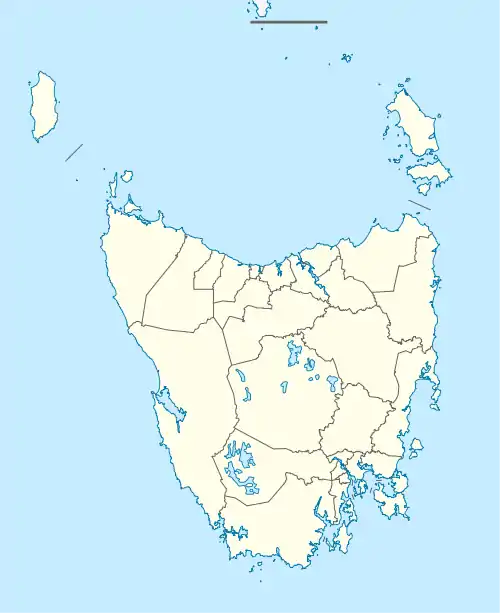Marion Bay, Tasmania
Marion Bay is a large bay and a bounded locality on the south-east coast of Tasmania, Australia. It is near Dunalley in the municipality of Sorell. Its south-western shore is contained by the Marion Bay Important Bird Area.
| Marion Bay Hobart, Tasmania | |
|---|---|
 Marion Bay | |
| Coordinates | |
| Postcode(s) | 7175 |
| LGA(s) | Sorell Council |
European discovery
Abel Tasman first anchored just north of a small island in the southern part of this large bay in 1642, and landed in the area he named Frederick Henricx Bay (made up of what is now called Blackman Bay, Marion Bay and North Bay).[1] The name Frederick Henry Bay was mistakenly moved to its present location by Captain Tobias Furneaux. Subsequently, Frederick Henricx Bay was later named Marion Bay after the Breton navigator Marion du Fresne, who arrived in his ship the "Mascarin" with the "Marquis de Castries" in March 1772. Marion recorded that "One sailor found numbers of crayfish, lobsters and huge crabs, and the oysters there are good and abundant" [2]
Marion's landing is the first recorded sighting and description of the Tasmanian Aboriginal people by Europeans, unfortunately one of the Aboriginal men was shot dead by Marion's men. Marion then sailed to New Zealand where he was killed by Māori in the Bay of Islands.
Festivals
Marion Bay was host to the first Tasmanian Falls Festival in December 2003. It attracted more than 10,000 people and has become an annual event, as has the festival's counterpart in Victoria, Fremantle and latterly Byron Bay.
The Bream Creek Show has been taking place in Marion Bay for more than a century. Noted for a display of monster pumpkins, the show was first hosted in 1897 in the pavilion at Coppington. It is held every year in March and includes rides for kids, wood chopping and other family entertainment.[3]
Army worm infestation
In December 2008, an infestation of Army worms in Marion Bay was reported in the national media. Despite the problems residents encountered, infestations of this sort are apparently common wherever the worms are.[4] In October 2008 a general alert was sounded that such an infestation was likely to occur.[5]
References
- The Tasman Map (1644), The Mitchell Library, Sydney
- R.W.Giblin, The Early History of Tasmania, <date?> p. 37-40
- "Tourism". Sorell Council.
- (Video)
- News report, TAS Country Hour, ABC Rural Archived 26 August 2003 at the Wayback Machine